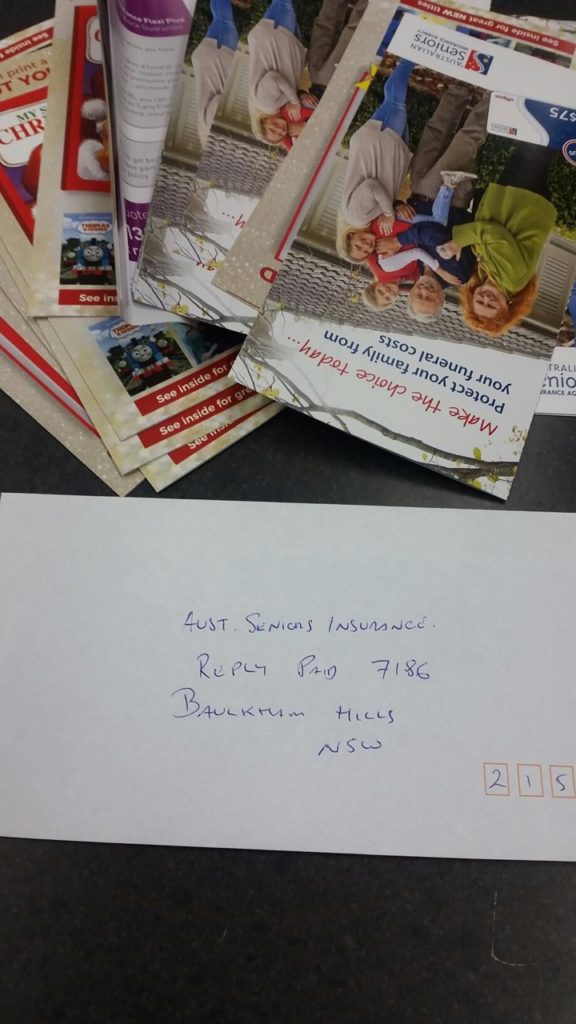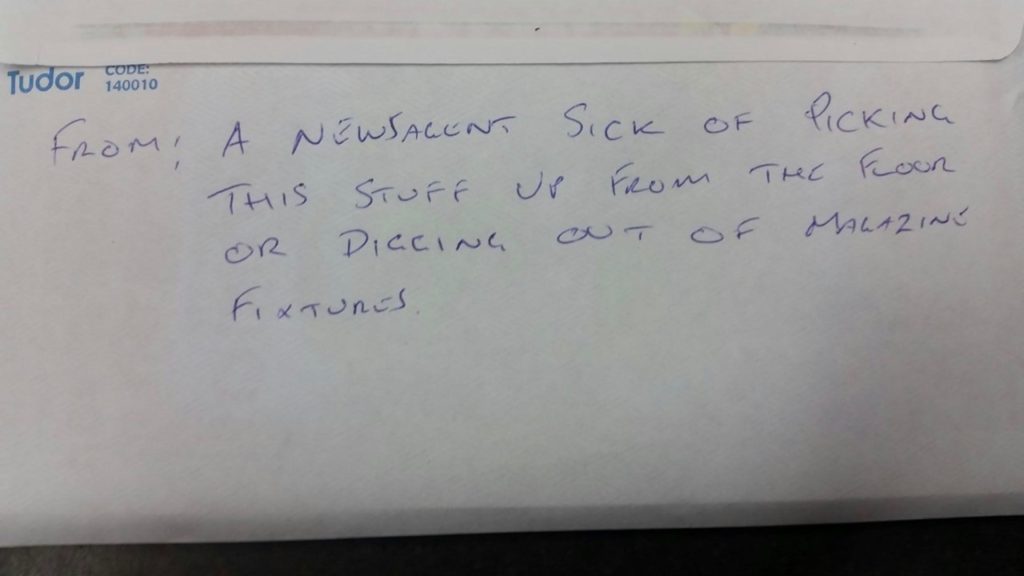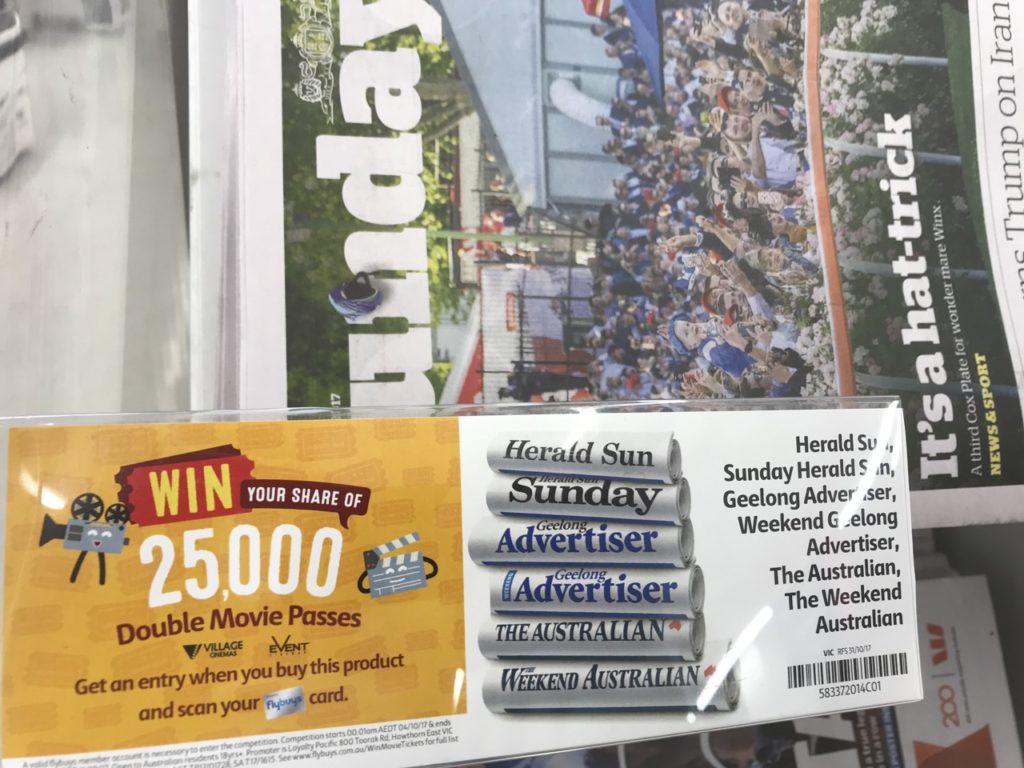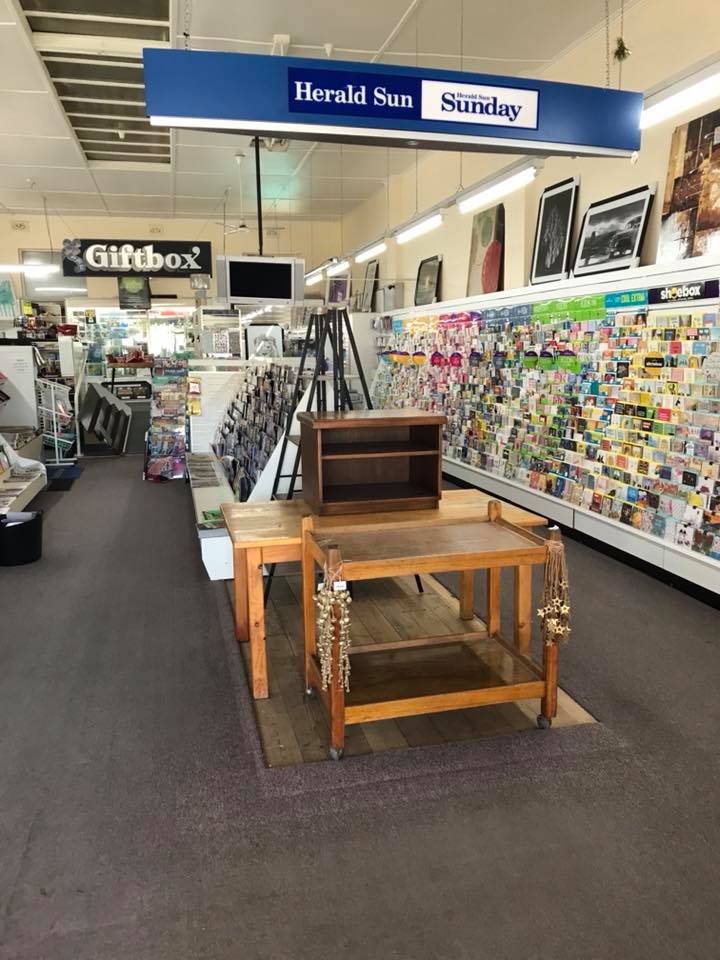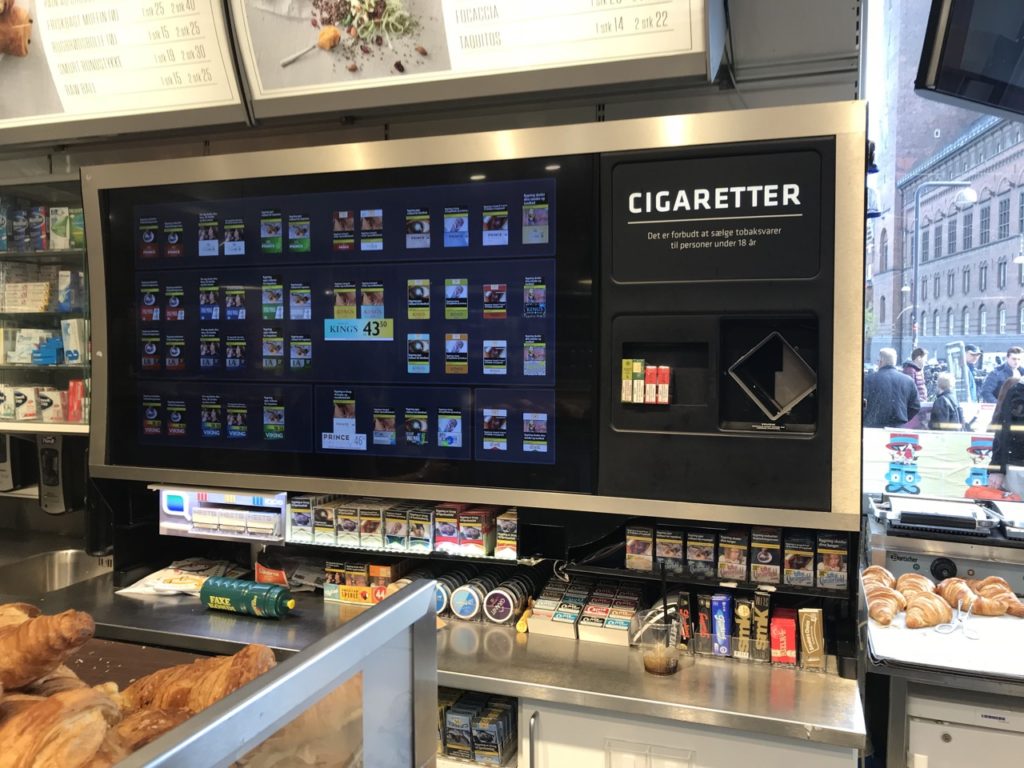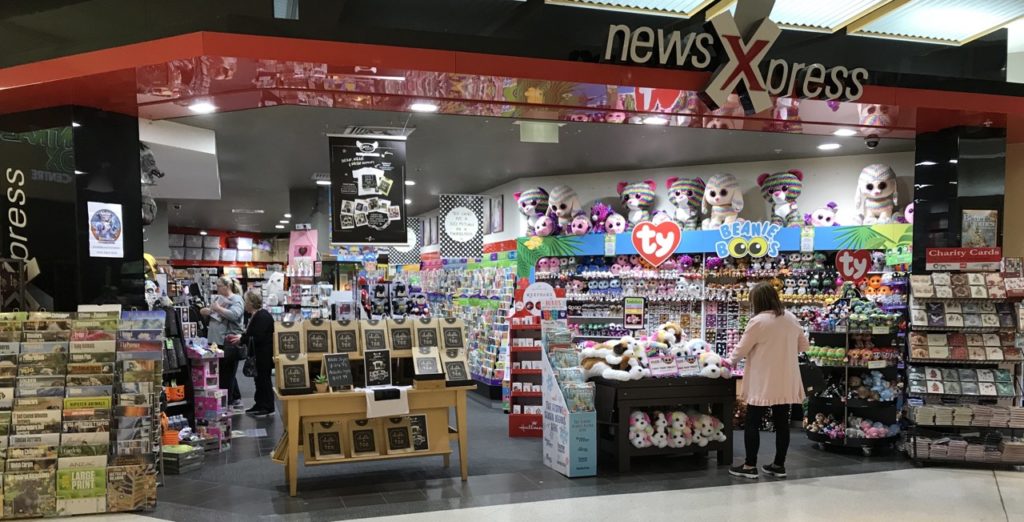News Corp newspaper promotion in Coles
I noticed this promotion with 25,000 double movie passess on offer in a Coles supermarket on the weekend. It was being promoted on in-store radio as well.
This is a sweet deal. It is being managed by Loyalty Pacific News Corp and Coles. To get in on the deal the shopper needs to purchase using your FlyBys card.
Thinking about it, it is smart marketing as they are focussed on getting the supermarket shopper to add a newspaper, or two, to their basket.
Coles is an easy platform as all stores in their large national network are corporate owned, the whole organisation is KPI engaged and they have platforms for driving this – in-store radio, front of store displays and an integrated loyalty program.
Sunday newsagency management tip: know your occupancy cost
Newsagents, and just about any small business retailer, often complain about rent. Many who do complain do not know their occupancy cost. This is the ratio of rent to product sales where product sales include agency commission.
Knowing your occupancy cost is key to every discussion you can have on rent.
Here is the advice I have provided previously on occupancy cost:
Occupancy cost: between 9% and 11% of revenue where revenue is product revenue plus commission from agency lines. Location and situation are a big factor in this benchmark. For example, a large shopping centre business will have a higher cost than a high street situation.
How are sales for tonight’s $21M superdraw?
A colleague has asked me to ask folks here how their sales have been for tonight’s superdraw, because their sales show now measurable bump.
More newsagents embracing cloud-based school booklist service
Last year, my software company launched Booklist, a cloud based school booklist management solution designed to help newsagents compete with big businesses chasing school book list business. The goal was to provide newsagents a facility through which they can be seen by customers as more up to date and through which they can cut the time it takes to manage booklist orders.
Newsagents have had direct input into the 2018 school year release, which is now live.
Using the site, newsagents can:
- Setup a school.
- Setup classes in a school and load all the booklist requirements for each class.
- You can easily copy booklists, to make setup easy.
- The booklist items could be loaded by a CSV file. You record item description, price, supplier and supplier stock cost.
- You setup order close dates.
- You note when an order is ready for collection, this advises the customer.
- The site allows you not having stock, thereby adjusting the amount to be collected.
- You share a link for parents to sign up and add their kid(s) to a class and to either take the whole booklist or select what they want.
- The site allocates logins to parents so they would have access to their order.
- Receive payment from the parents, direct into your account, online. Alternatively, customers pay on pickup.
- Export a file of all items required to fulfil booklists, by supplier and by school. CSV you could load into Excel.
- Report on total revenue by school and class. This helps if you have a rebate in place.
- The site is accessible by desktop, tablet and phone.
In addition to the per year fee there is a small card processing fee, on a cost recovery basis, for payments made online.
Here are the enhancements guided by newsagents:
- Store can publish and unpublished a booklist, aiding setup and management.
- Store be able to copy a booklist from one year to the other year within the same school
- Store be able to personalised the booklist name for each year
- Store be able to add multiple booklists to a year level
- Store be able to define a year level themselves, for example “Year 2/3”
- Store be able to generate a sales report for selected schools within a selected date range
- Store be able to generate a product report for selected schools within a selected date range
- Store will be able to add comment to order when they update order status, the comment will be sent to the customer in email
- Store will be able to filter order status in the store backend for example view “completed” orders only
- Added “Booklist Review” step, before store confirm to create the school booklist.
- Fixed the website URL from frontend.booklist.com.au to www.booklist.com.au
From this project it is clear there is no one approach to managing school book list sales. The developers sought to address the most common and commercially viable needs to provide a cost effective solution for newsagents.
To access the preview please follow these instructions.
Demo Store URL https://demo.booklist.com.au
Demo Schools https://demo.booklist.com.au/available-schools
Demo Store Backend Login
| Store Login | https://www.booklist.com.au/login |
| Store Username | demo |
| Store Password | booklist |
Any questions, email help@booklist.com.au
If my first job in a newsagency decades ago I packed school book orders. I remember the manual accounting process well. My hope is this cloud based facility encourages more newsagents back into this area newsagents once owned.
Promoting early Christmas card purchases
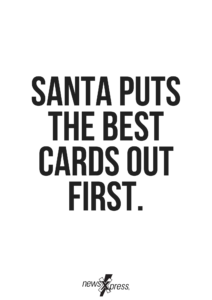 We are engaging in-store and out of store campaigns to attract earlier shopping for Christmas, especially for Christmas cards – both single and boxed.
We are engaging in-store and out of store campaigns to attract earlier shopping for Christmas, especially for Christmas cards – both single and boxed.
We are using several messages in the campaign, designed to engage in a light way with the early shopping opportunity.
I like the monochrome collateral created by a team member as it sits well against colourful cards. Too often I see colourful collateral with cards, and it is lost.
The messaging in the campaign will change over the next four weeks for what we consider to be the early part of Christmas shopping. The messaging is consistent in-store and online, to leverage the value of repetition.
It is important we evolve how we pitch our businesses. People will pay less attention if our messaging does not change, because it will be the same old.
If you are worried Christmas this year will be the same as or worse than last year, you still have time to change your messaging, brings in new stock and create a different story to what you have done before.
Average results happen in businesses where they do average things.
Gotch credit card facilities down?
A newsagent has let me know Gotch contacted them advising their credit card facilities were down this month. Has anyone else heard this?
WA newsagents pushing back against Lotterywest online campaign
Newsagents in Western Australia are removing promotional material in-store for Lotterywest online gaming sign up as a dispute with the state government owned lottery operator escalates.
While the newsagent / Lotterywest relationship improved with the change of government earlier this year, recent pressure from Lotterywest for newsagents to promote a service from which they make no money has seen a setback in progress.
How this matter is handled is vitally important given the awful few years in the newsagent / Lotterywest relationship leading up to the change of government.
Watch this space as WA newsagents work together to agitate for fairness.
There is no doubt that Lotterywest needs to serve customers online. They are behind Tatts on this front. However, they need to do it with newsagents, to show a small business partnership can work, to show the Tatts ignorance of and refusal to genuinely respect newsagents is the wrong move.
Newsagents have been the retail face of lotteries in Australia since launch.
Most newsagents see lottery each customer as their customer.
Many newsagents have won and nurtured these customers.
Newsagents have done the hard yards.
Tatts misses these points.
Hopefully, Lotterywest respects newsagents for what they have done and can do for the community owned business.
NEDS pitching online gambling
With NEDS now launched, there is another gambling player that is spending up pitching online versus in-store. While not pitching lottery products it is chasing dollars from the same pool.
The value of specialisation in independent retail
 Specialisation is more important in independent retail today than ever.
Specialisation is more important in independent retail today than ever.
With the lines between retail channels blurred what was a differentiating yesterday is no longer today.
Take stationery. Our channel dominated this twenty years ago. Today, we are not dominant with supermarkets, stationery specialty, online and new stores like Typo, Kikki.k and Smiggle doing this far better than us.
Look at the five pillar categories on which our channel was built – newspapers, magazines, cards, stationery and lotteries – each of these is available outside our retail channel with more purchase outlets being added.
On the upside, opportunities abound for businesses that specialise well.
By specialisation I mean going deep into a niche or product category and serving the interest well through product, knowledge and service.
I have seen newsagency businesses redefine themselves by specialising in a way then had never before considered, often in a category or niche far from what was traditional for a newsagency business. In the cases I am thinking of, they have not fully turned their back on the traditional newsagency offering. Rather, they have introduced their specialisation within their business, as an add on, bringing to the business a valuable additional traffic driver.
Specialisation does not need to dominate the business. However, it does need to be enough for people to be prepared to drive a distance to see what you have or to purchase over the hone or online because of your broad and unique range.
The photo with this post is a wall of playing cards I found in a store I visited recently. It has more cards than I can recall seeing in any other business. This is the type of specialisation I am talking about – affordable in terms of inventory investment, space and management time.
There is no limit to what you could specialise with. That is what is terrific in this consideration. You can specialise with products that stray far form what one might usually find in a newsagency. Your specialisation is an opportunity to create a business within a business, to give a new range of shoppers a reason to consider your business.
While specialisation can be challenging, the benefits can be considerable. Take your time as it could be you need to try several concepts before you find what works in your business.
This is what is important in retail, evoking your business, evolving your focus, reaching new audiences.
Standing still is not an option.
Making the most of limited space in-store
Check out the card and packaging fixture I saw on the weekend in a store that has limited space availability.
Newsagents with Tyro can offer Afterpay in their shops
Through my POS software company I have been working with Tyro to make access to Afterpay (buy now pay later) easier.
If you are a Tryo customer, regardless of the software you use, click here to register your interest. Tyro will contact Afterpay for you.
Afterpay has its own sign-up that you will need to complete, but Tyro will kick that off for you.
Click here to learn how you will process Afterpay payments through Tyro. It includes screen shots to guide you. This is the first step approach. It is available now. The goal is for a tighter integration with the POS software but that depends on Afterpay.
Afterpay could replace LayBy in some instances.
Newsagency marketing advice: use videos on social media
Using a video on social media to pitch a product range can be far more effective that still photos. Experts disagree on time and other factors for videos. I have found that for most products I pitch, a video of between 15 and 30 seconds works best. It needs to be not over-produced. It needs to feel it is from you.
Here is an example of a video I used in a Facebook promotion recently, the engagement was terrific, including plenty of shares of the video. Purchases flowed as a result. It is simple, not produced. Those types of videos tend to work better in my experience.
Newsagency management advice: schedule stock deliveries
When you order stock, consider being specific about when you want stock delivered. Group deliveries together, so that you may roster the business to make for the most efficient arrival of stock.
If you leave it to suppliers you might have stock arrive each day of the week when a more efficient solution could be to have two days set aside for processing this.
Depending on your competitive situation, you may want to leave deliveries coming as they are and only process the new stock on set days.
I appreciate the value of new product hitting the shop floor every day. However, managing the business for efficient use of labour is key given that labour is usually the second or third biggest operating cost for any retail business.
One option is that you arrive the stock, price it and have it ready for shop floor display on the day you nominate.
Lottoland pitches in media for newsagent support
 At the same time Lottoland wrote to ALNA offering what appears to be a commission to newsagents they engaged a PR campaign, giving the ALNA letter to journalists. It’s been reported in newspapers and online. Lottoland CEO Luke Brill says Newsagents are an important part of Australian communities… So important that newsagents were mocked by Lottoland.
At the same time Lottoland wrote to ALNA offering what appears to be a commission to newsagents they engaged a PR campaign, giving the ALNA letter to journalists. It’s been reported in newspapers and online. Lottoland CEO Luke Brill says Newsagents are an important part of Australian communities… So important that newsagents were mocked by Lottoland.
If Lottoland were serious about mending bridges with newsagents they would make their pitch, apologise for the harm they wreaked on newsagents and their families, negotiate their offer and then talked publicly about it. Instead, Lottoland made a somewhat vague pitch and gave it to at least one journalist as the same time.
Lottoland needs to apologise, publicly. They should promote newsagents on TV in a national make-good campaign. They need to do this first, as a gesture of good faith, to remonstrate their their pitch today is genuine. Apologising and declaring they were wrong is the starting point.
Footnote: I remain firm in my view that online overall is the biggest challenge to newsagent lottery revenue. Here in Australia, the lion’s share of online is driven by Tatts. They are the newsagents competitor.
Is the fax machine redundant in today’s newsagency?
We have not had a fax machine in one of my newsagencies for two years.
There has been no negative impact on customer service or revenue.
Customers who ask to send a fax are offered a lower cost, and easier, email service alternative.
The fax machine is very much yesterday’s technology. It has a limited life before a new machine is needed. Plus, it relies on consumables and often uses an additional phone line.
I can’t see the value in putting a fax machine into any newsagency.
I understand in some locations there could be thought of offering a fax service as a point of difference. To that I’d suggest that you need to understand the break-even point for the capital invested. That analysis may result in the value of offering a fax service being reinforced.
Offering a fax service could pitch your business as old-school to some and that may not match the image you want for the business.
With copiers offering PDF services, it is easy to fill in forms and return them to suppliers. Ideally, however, such forms move online, eliminating paperwork and handwriting.
All of this is about eliminating processes and making our businesses more efficient.
The purpose of this blog post is to get you to think about whether offering a fax service is right for your business and to open a conversation on the topic.
How poor quality NBN is negatively impacting small business retailers including newsagents
The National Broadband Network (NBN) being rolled out in Australia today is not the NBN Australians were promised during the election campaign when it was first pitched.
Instead of (fast) fibre to the premises as was initially rolled out under the Labor government, for some years now under the Liberal/National Party the NBN rolled out has been Fibre to the Node, which relies on the old copper network to get data from the Node to the Premises.
I have the old NBN at my home, the original NBN, NBA fast. It is fast.
I have used the new NBN, let’s call it NBN slow in multiple locations. It is noticeably slower.
While plenty of pro NBN slow people say, there is no issue as most people use the NBN to watch entertainment or use social media.
A fast NBN is key for business productivity. With the amount of data flowing between businesses, websites, suppliers, speed is an issue in commerce today. Slow speed = a less productive experience. This is how NBN slow is an inferior product to the original NBN, it is how what is being rolled out today is hindering businesses.
Beyond retail and in businesses like my POS software company NBN speed is key to overall business productivity. Every day we see examples of the cost of NBN slow and the negative impact it is having on small business.
There is no denying this. A read of the tech specs of the two NBNs leave no possible conclusion than that NBN slow is slower. I say this is bad for the economy.
Globalisation has been a push by politicians for decades. Globalisation only works if all in the party have the same tools and are on equal platforms. Australia at the globalisation party is not on the same platform. It is on a slower, second-rate, platform.
This only came about so one side of politics could defeat the other, by using an argument many in the street would not understand. Unfortunately, it is the many in the street who will suffer consequences for years to come from NBN slow.
The technical platform for NBN should not have been a political decision. It child have been a technical decision, on merits, focussed solely on what is best for Australia.
The impact on small businesses, like newsagencies, will be felt for years to come. Our businesses will continue to evolve, relying more and more on being online 24/7. Plenty will be held back from what they could achieve by NBN slow.
Shelve politics when thinking about this. This issue is about productivity. The cost gap between the two NBNs is minimal, and would have been easily covered by an improvement in productivity.
Looking at the other way, we as a country are paying a high price for a slow service by world standards.
Tech experts elsewhere do not understand d why Australian politicians decided to switch from a best-practice NBN to a worse than mediocre NBN. I agree with them.
Communication from ALNA from an approach by Lottoland
Luke Brill, CEO of Lottoland, visited the ALNA head office to talk newsagents, almost a year after his company started attacking and mocking our channel, calling on shoppers to stop shopping in newsagents.
here is a report from ALNA about the visit:
Lottoland’s Desperate Plea
Lottoland CEO Luke Brill visited the ALNA head office to ask us to join them and refrain from the fierce lobbying campaign that we have been undertaking in the last 18 months.On the top of his agenda was the plan to engage newsagents to sell his product. ALNA CEO Adam Joy made it very clear that Lottoland had damaged the relationship with news and lottery agents by:
- Producing advertisements that intended to harm newsagents and humiliate them publicly by labelling them unable to move with the times.
- Leveraging of the news and lottery agents hard work in the misleading way he communicated to members of the public
- Holding interviews outside newsagencies
- Using imagery and wording so close to the official lotteries that led to confusion for customers
- Ignoring the original and official channel for news and lotteries initially by taking a belligerent approach to proceed without any consideration for the community benefits from news and lottery agents
- Deliberate marketing to undermine current jackpots.
- Promoting large discounts and special offers to gamble with Lottoland instead of playing the official draw
- Misleading social media advising customers they could play all their games in one APP.
- Dishonesty in interviews where Lottoland claimed to not be targeting newsagent customers and claiming they are seeking new customers, Adam challenged this and asked why they use imagery, wording and colours of an Official Lottery? The answer provided by Brill did not answer the question.
Mr Brill said he would happily run a new TV advert where the person went back into the newsagent and was elated they could now access Lottoland. Adam advised that this was patronising and further enhanced the feeling that we were behind the times and late to the party.
Adam challenged Mr Brill on his comments from last meeting, where he claimed they will fly as close to IP replication without infringing, Mr Brill confirmed this was still their intention.
ALNA feel a public Apology in TV, Radio and print apologising to the network and transparently declaring that they have used existing IP and Newsagents to leverage their business and in our opinion that this was misleading.
It is apparent the recent announcements we have achieved by working in unison with the WA VIC, NSW and Tasmanian Governments have them rattled. He tried to talk about Tatts Lotteries with Adam about what Tatts are doing to retailers, Adam advised him that we have a separate discussion with Tatts and that this is irrelevant to the Lottoland plan to leverage newsagent customers.
ALNA continue to work with the other states and federally for a total announcement. We heard in Tasmania on the weekend even if the opposition win the next election they will also ban the wagering on the outcome of lotteries.
Further evidence of Lottoland’s plan for official lottery customers, Lottoland again extended an offer to pay newsagents a monthly marketing fee and a trailing commission on all transactions. Adam challenged why he would do this if he did not want newsagent customers and were focused on new customers? The response was so ALNA would leave Lottoland alone.
Mr Brill then went further and said, “what if we stopped focusing and transacting on domestic lotteries and only focused on overseas jackpots?” Adam advised this was an unanswerable question as there are many variables to this
- This does not stop other lotto wagering companies in the domestic market. E.g. nedd lotto, magpie millions and others.
- Lottoland could trade under another name and do this e.g. the white labelled William Hill product Planet Lottery.
- There is no guarantee of the length of time Lottoland would commit to this
- How could we trust Lottoland going forward?
Adam asked if they could change their name to Bet on Lotto and be transparent to what it is? The answer was that they have built a good brand around Lottoland. Adam interrupted and said on the back of news and lottery agents and the official imagery and words?
Mr Brill ended the conversation advising he will put an offer in writing to Adam, Adam advised he would share it with the Board and members but did not hold high hopes for its adoption.
How the retreat of banks from regional and rural Australia hurts small businesses retailers and the communities they serve
More Australian banks are pulling out of country towns, leaving local businesses and individuals without any over the counter bank services. They are closing branches and agencies.
In one situation recently, a regional town with a population of 2,000 saw its last bank brand close, leaving locals a forty-five-minute drive to the nearest bank. This means local businesses have a round trip of ninety minutes just to bank business takings, increasing business costs by hundreds of dollars a week as banking, which used to be done locally daily, now must be done three times a week resulting in four and a half hours in the can and at least another hour and a half parking, waiting and more.
This impacts on how a business operates.
While some businesses can operate by promoting cashless trading, in regional and rural towns with an older demographic, cash is preferred in everyday retail businesses like newsagencies.
In not banking every day, small business retailers carry more cash on their premises. This increases the risk of theft. Insurance company representatives have said this could result in higher premiums. The costs resulting from banks reducing their level of customer service cascade, hurting further these vulnerable local businesses that matter to their small local communities.
In having to bank far away, this increases the risk on the long journey to and from the bank.
With so many small business retailers in regional and rural Australia, matters such as the closure of local bank branches and agencies matters. Newsagents are being affected as are their customers and their suppliers.
It is possible that a local bank closure is enough to tip a local business owner to closing a local retail business. The knock-on effect on local jobs, local suppliers and out of town suppliers like us would be noticed.
I think there is a role for government here to offer an operating cost subsidy to banks that maintain regional and rural banks in towns with a lower than agreed population threshold. While I am not usually a fan of subsidies, in this situation there is merit, especially for small towns.
I think such a policy of support would not only help small businesses like newsagents, it would improve the appeal of the town for new residents as well as improving security for those who use the bank.
Locally owned small business retail is vital in any situation, but more so in regional and rural towns. The retreat by banks is an operational challenge that disadvantages regional and rural Australia and this is bad for the economy.
Through my POS software company Tower Systems I am actively supporting calls by small business retailers for government action to provide support for local banking services.
Plastic bag issue finally getting resolved
The announcement by the premier of Victoria last night that they will ban single-use plastic bags brings Australia closer to a national resolution of this issue. The opportunity is for retailers to get on the front foot and pitch a bag solution that eliminates not only plastic bags but the degradable bags often put in their place.
This is an opportunity for us to change the conversation about bags.
Sure, there is a challenge with the newspaper customers who often demand a bag so they keep their hands clean. It is time for them to be accountable in my view. These bags are a waste of money. They do not drive shopper loyalty.
On gifts and other items, the opportunity is for a higher quality reusable bag that pitches differentiating points about the business.
Is Lottoland for real in its latest claims?
In commenting about the announcement from the Queensland government that they plan to ban Lottoland, Luke Brill, Lottoland CEO said:
The majority of Lottoland’s customers have never bought a lottery ticket in a newsagency, and are largely online sports betters who are embracing new technologies.
The Lottoland TV campaign that has run for most of this year does not support this opinion. They directly targeted newsagents, in an apparent effort to redirect newsagency shoppers to Lottoland. I call their claim – The majority of Lottoland’s customers have never bought a lottery ticket in a newsagency – as bullshit.
The Lottoland TVC also sought to educate customers about technology. If Lottoland customers are embracing new technologies then why promote it as they did?
Brill goes on to say:
We are open to talks with the Australian Lottery and Newsagents Association about a model that lets newsagents cash-in on online punters. We want to grow the market together, not try to destroy it like Tatts is doing in a bid to maintain its monopoly.
If true, they have left it to late in the day to try and work with newsagents. They have spent most of 2017 mocking newsagents. If they really want to grow the market together they need to apologise for the damage they did to the reputation of newsagents.
I don’t think Tatts is trying to destroy the market as Brill claims. I think the opposite is true. I think Tatts is trying to grow spending on its products. However, I think Tatts’ prime focus by far is on its revenue with minimal regard to revenue for newsagents.
That is an issue separate to the Lottoland issues. It is unhelpful that Lottoland links them.
Lottoland’s behaviour is like the kid who got caught misbehaving and responds by pointing to another kid and saying what about them. Grow up Lottoland. Own your situation and own that you have spent 2017 denigrating newsagency businesses, those who own them and those who working them.
Brill is becoming shrill because successive state governments are acting, like South Australia did earlier this year, to make the sale of Lottoland and similar products illegal.
